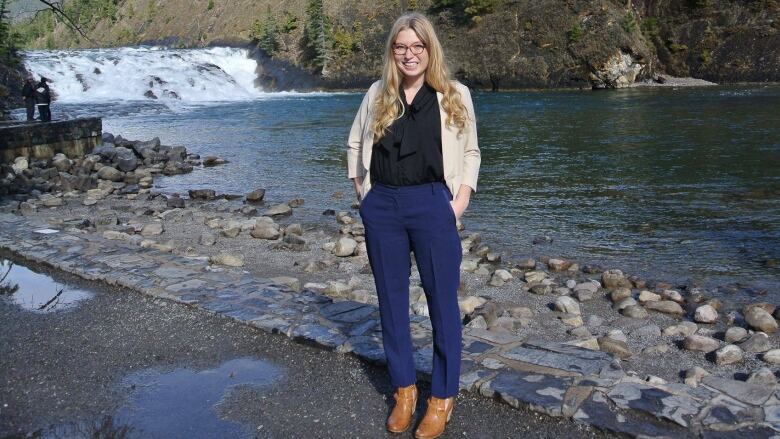Dandelion fungi could help clean toxic oilsands tailings, says Edmonton scientist
Award-winning innovation garners widespread interest from industry including support from Syncrude

Kelcie Miller-Anderson's obsession with science began with a single dandelion, sprouting from the sunbaked pavement of her back-alley.
Wondering how the weed managed to flourish in such harsh conditions, Anderson then just 15 years old set out to solve the mystery.
She built a makeshift laboratory in the basement of her Calgary homeand started experimenting on the prolificbloom.
What she found could help eradicate one of the oilsands industry's largest environmental problems,the toxic tailings ponds created by the bitumenmines.
"I did some research and I actually discovered that dandelions are accumulating a fungi into their roots," said Miller-Anderson, who now studies environmental sciences at the University of Alberta.
"And it's this relationship between the fungi and the dandelion plant that enables them to really grow anywhere."
As she watched the dandelion fungi devour the hydrocarbon-rich soil, Miller-Andersonrealized that itcould be a powerful reclamation tool.
'Just like mushrooms do in nature'
Mycoremediation harnesses the power offungi to remove contaminants from the soil, and Miller-Andersongot to work applying the process to tailings, holding ponds filled with silt, salt and a slurry of chemical compounds.
After extracting the fungi from the roots, Miller-Anderson first used soybeans as a conduit for the dandelion spores and the results were promising, but she wasn't satisfied.
Concerned about the ability of soybeans to thrive in northern Alberta climates, she switched to a different species the oyster mushroom.
Large clusters of these pedestal-shaped fungi can be found growingfrom the trunks of trees across the boreal forest.
They proved a powerful conduit.
When placed in both solid and liquid tailings, they worked quickly. Within three weeks, she saw a dramatic drop in thepH of the material, salt concentrations, residual hydrocarbons and naphthenic acids.
"Mycelium is the vegetative part of fungi so this mycelium is able to branch down into the soil and just like mushrooms do in nature, it's able to digest and remediate the contaminants in that soil," said Anderson, who is now the founder of her own company, MycoRemedy.

After seven years of research and field trials, Miller-Anderson's method now takes the form of what she calls a "myco mat."
Much like a piece of sod, thefungi-laden mats are laid out on top of the tailings, before releasing powerful enzymes that make a meal of the hydrocarbons.
The mats are biodegradable so there's no additional cleanup.
Unlike current remediation methods which usually involve the excavation and removal of contaminated soil her process is all natural and fast.
"Essentially, you roll out the mat and leave it there to do its job. And it's very rapid. We had in our initial test results, in 21 days, elimination of hydrocarbons from the soilcompared to most sites with the dig-and-dump method that take several years to complete."
Miller-Anderson has won numerous awards for her workand has garnered widespread interest from the industry, including long-term research support from Syncrude and Alberta Innovates. Next week, she'll take her idea to the finals of the Global Student Entrepreneur Awards in Vancouver.
'Something that nature is already doing'
She hopes to refine the method to ensure the fungi can reach even deeper into contaminated areas, with an eye to expand the application to gas stations and abandoned oil well sites.
To that end, she'll be conducting more field trials this summerand is confident her invention can help reverse some of the damage caused by the industry.
"It's really interesting to me because it's something that nature is already doing," she said. "It's a natural solution, so it just seems like the best choice."
With files from Mark Harvey












_(720p).jpg)


 OFFICIAL HD MUSIC VIDEO.jpg)
.jpg)



























































































